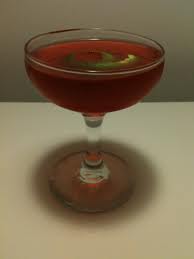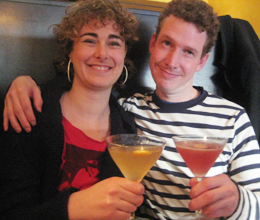 The Jack Rose is a cheerily pink cocktail that was all the rage back in the 20s and 30s. Despite the frivolity of its color, its flavor immediately announces it as a serious drink, worthy of attention. The masculinity-conscious man who would shun it due to its girlish hue foolishly limits himself. As my authority may not be sufficient to establish this point, I yield the floor to none other than Ernest Hemingway, in his classic The Sun Also Rises:
The Jack Rose is a cheerily pink cocktail that was all the rage back in the 20s and 30s. Despite the frivolity of its color, its flavor immediately announces it as a serious drink, worthy of attention. The masculinity-conscious man who would shun it due to its girlish hue foolishly limits himself. As my authority may not be sufficient to establish this point, I yield the floor to none other than Ernest Hemingway, in his classic The Sun Also Rises:
At five o’clock I was in the Hotel Crillon waiting for Brett. She was not there, so I sat down and wrote some letters. They were not very good letters but I hoped their being on Crillon stationery would help them. Brett did not turn up, so about quarter to six I went down to the bar and had a Jack Rose with George the barman. (Ch. VI)
Of course, it could be that the choice of drink is supposed to be symbolic of Jake’s lack of manful fortitude — I’ll take my chances.
1 1/2 oz. applejack
1/2 oz. lemon or lime juice
1/2 oz. grenadine
Shake or stir on ice, serve straight up with a lime garnish
Applejack is brandy made with apples, but it is not called Calvados because it is made in the United States, and Calvados can only be made in France. Compared to Calvados, applejack has a more whiskeyish flavor. It is also more affordable. Laird’s applejack costs about $20 a bottle and seems to be somewhat easy to find.
Applejack happens to be close to this blog’s heart thanks to its role in the ruin of Richard Whitney, president of the New York Stock Exchange in the era of the Jack Rose:
Whitney’s dishonesty was of a casual, rather juvenile sort. Associates of the day have since explained it as a result of an unfortunate failure to realize that the rules, which were meant for other people, also applied to him. Much more striking than Whitney’s dishonesty was the clear fact that he was one of the most disastrous businessmen in modern history. Theft was almost a minor incident pertaining to his business misfortunes.
In the twenties the Wall Street firm of Richard Whitney and Company was an unspectacular bond house with a modest business. Whitney apparently felt that it provided insufficient scope for his imagination, and with the passing years he moved on to other enterprises… He had also become interested in the distilling of alcoholic beverages, mainly applejack, in New Jersey. Nothing is so voracious as a losing business, and eventually Whitney had three of them… When one loan came due he was forced to replace it with another and to borrow still more for the interest on those outstanding. Beginning in 1933 his stock exchange firm was insolvent, although this did not become evident for some five years…
In 1933, Richard Whitney and Company… had invested in between ten and fifteen thousand shares of Distilled Liquors Corporation, the New Jersey manufacturer of applejack and other intoxicants…
Unhappily, popular enthusiasm for the products of the firm, even in the undiscriminating days following repeal, was remarkably slight. The firm made no money and by June 1936 the price of the stock was down to 11. This drop had a disastrous effect on its value as collateral, and the unhappy Whitney tried to maintain its value by buying more of it. (He later made the claim that he wanted to provide the other investors in the company with a market for their stock, which if true meant that he was engaging in one of the most selfless acts since the death of Sydney Carton.)… Mention has been made of the tendency of people in this period to swindle themselves. Whitney, in his effort to support the stock of Distilled Liquors Corporation, unquestionably emerged as the Ponzi of financial self-deception. (J.K. Galbraith, The Great Crash, pp. 166-167)
Cheers, to better luck and better judgment than Richard Whitney’s!
{ 0 comments }








